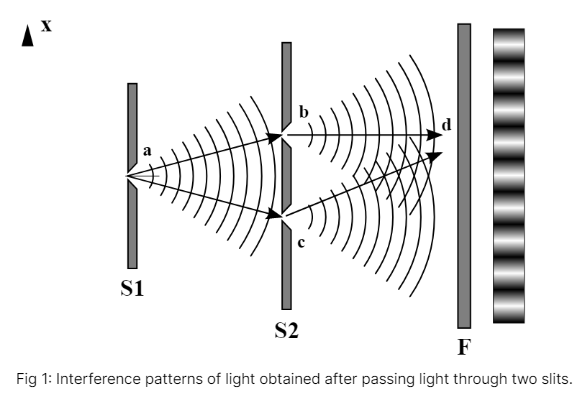Interference of light is a natural phenomenon observed almost everywhere. A pair of light waves pass over each other and create interference. Interference typically takes place in electromagnetic waves, and the most obvious example of interference is seen in light. Optical interference is responsible for the formation of rainbows or even the visibility of various colours in a soap bubble.
Interference of light refers to the superimposition of waves to form a resultant wave, which can be of the higher, lower, or the same amplitude. Amplitude is the height of the wave. When two light waves form a superimposed wave of higher amplitude, the phenomenon is called constructive interference. When two light waves form a superimposed wave of lower amplitude, the phenomenon is called destructive interference. Interference of light yields in the redistribution of energies of the source waves, which causes the formation of an interference pattern on screens.
Constructive Interference
When two crests or troughs of a wave align with each other to give a resultant amplitude that is higher, it is called constructive interference. Typically, it is the sum of the individual amplitudes of the waves. Such waves are said to be in phase, which means their phase difference is 0, or an even multiple of π.
The effects of constructive interference between two waves with the same amplitude and frequency (ω) can be described by the equations:
y1 = cos(kx – ωt), and y2 = cos(kx – ωt + δ )
Where δ is the phase difference between the waves, k is the wavenumber, x is the wave position, and t is the time.
Destructive Interference
When the crest of one wave aligns with the trough of another to give a resultant amplitude that is lower than the individual amplitudes, it is called destructive interference. Typically, it is the difference of the individual amplitudes of the waves. Such waves are said to be out of phase, which means their phase difference is an odd multiple of π.
The effects of destructive interference between two waves with the same amplitude and frequency (ω) can be described by the equations:
y1 = cos(kx – ωt), and y2 = sin(kx – ωt + δ )
Where δ is the phase difference between the waves, k is the wavenumber, x is the wave position, and t is the time.
Conditions for interference of light
For obtaining a light interference pattern that is sustained or retained, some conditions need to be fulfilled. They are:
- The light source must be coherent and in the same state of polarisation.
- The amplitudes and intensities of the light sources should be equal. This will ensure there is sufficient contrast between the maxima and the minima of the interference pattern.
- The light source must be monochromatic and a point source. E.g., lasers.
- The sources of light must be near enough to produce clear and sharp fringes.
- The source and screen should be far enough to produce wide but sharp fringes.
Experiment to understand the conditions for interference:
Thomas Young performed the double-slit experiment in 1801 that helped understand the interference of light. This experiment helped prove the wave nature of light.
By proving that light also moved like waves, Young successfully established, that like all electromagnetic waves, light also underwent interference of light when two light waves passed over each other.
He used one source of light, the sun, but passed it through two small openings or holes, small enough that they could be called slits. This ensured that clear and sharp fringes of light were produced and that the source of light would now be coherent. A single source of light also ensured that it was monochromatic. This way, he observed an interference pattern on the screen, depending on whether the light waves were crest to crest or crest to trough, i.e., same phase or opposite phase, respectively.

The above diagram demonstrates how the plane light waves arrive at a barrier that contains two parallel slits, S1 and S2. These two slots serve as a pair of coherent light sources, because waves emerging from them originate from the same wave front and therefore maintain the same phase relationship. The light from S1 and S2 produces a visible pattern of bright and dark parallel bands called fringes on the screen.
When the light from S1 and S2 arrive in the same phase, constructive interference takes place, making a bright fringe appear. When the light from S1 and S2 arrive in different phases, destructive interference takes place, making a dark fringe appear.
Conclusion
Interference of light yields in the redistribution of energies of the light waves. These energies realign and form new waves that may be constructive or destructive. Constructive interference is when the light forms resultant waves that are greater in amplitude than the individual waves. Destructive interference is when the light forms resultant waves that are lower in amplitude than the individual waves.
 Profile
Profile Settings
Settings Refer your friends
Refer your friends Sign out
Sign out






